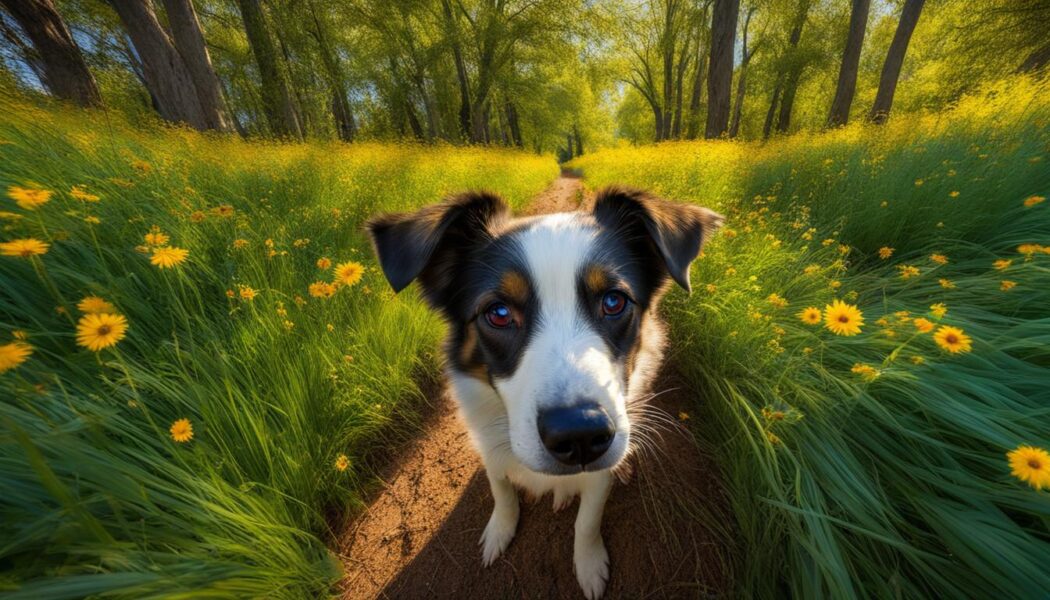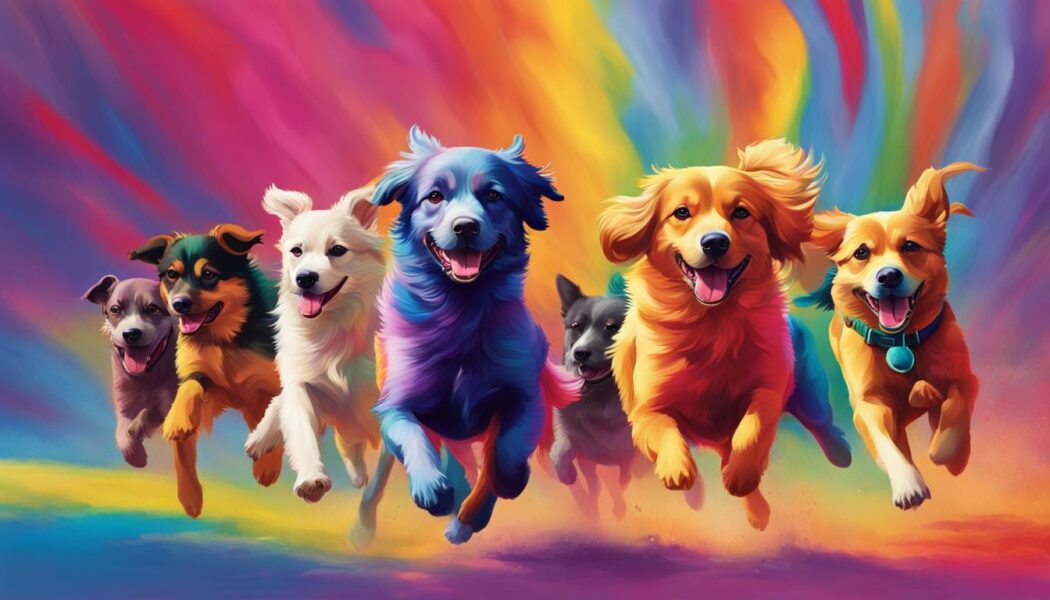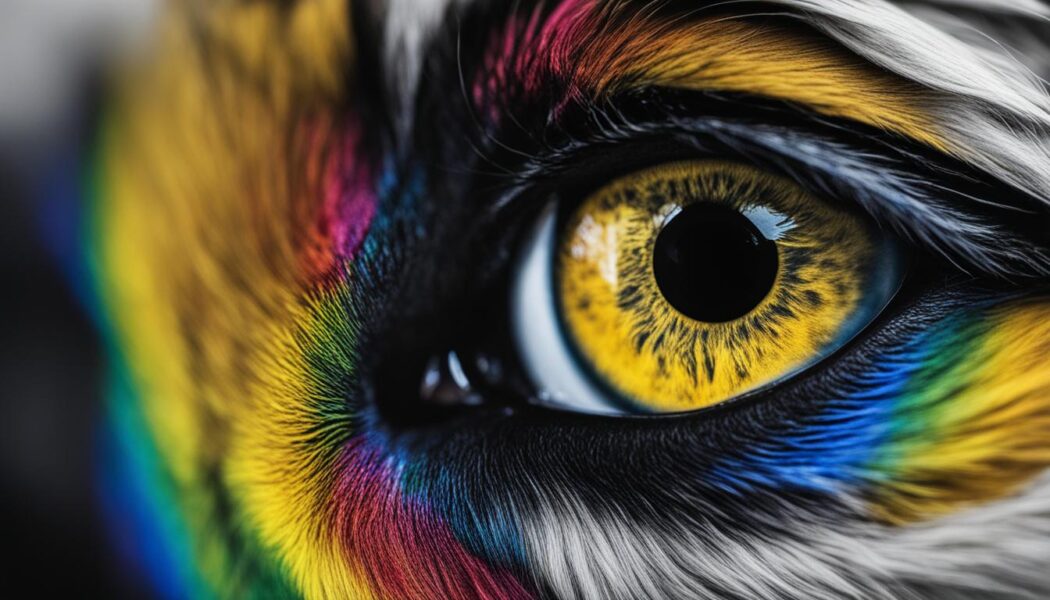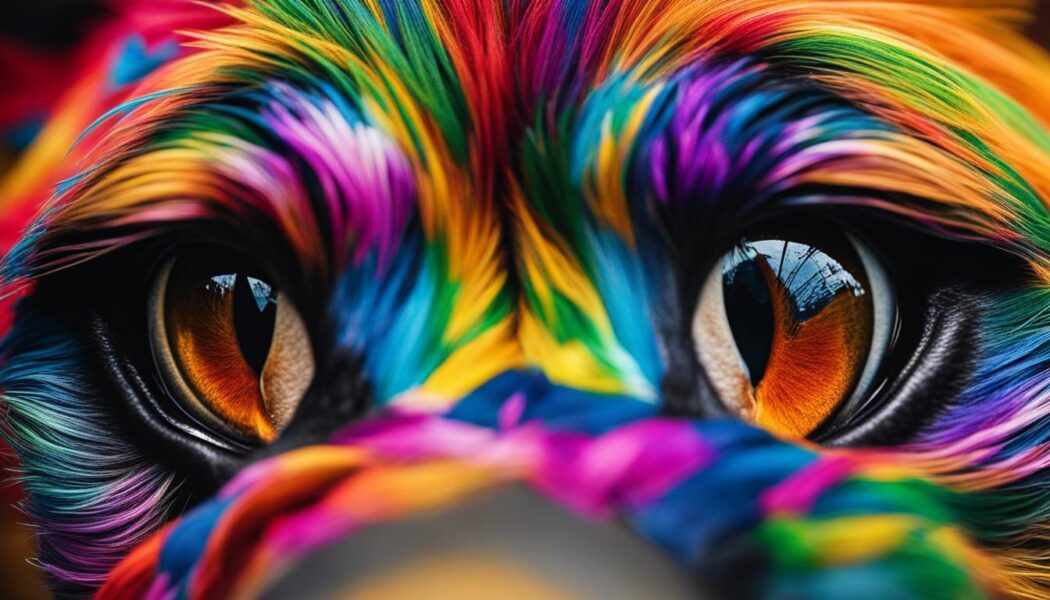As a dog owner, have you ever wondered what colors your furry friend can see? Most people mistakenly believe that dogs only see in black and white, but that’s far from the truth. Recent scientific research has revealed that canines possess dichromatic color vision, enabling them to see a range of colors, albeit limited compared to humans.
In this article, we’ll explore the fascinating world of canine color vision, the dog visual perception, and the color spectrum for dogs.
Key Takeaways
- Dogs possess dichromatic color vision, allowing them to see more than just black and white.
- Canine color vision is sensitive to blue and yellow wavelengths, making these colors more easily detected by dogs.
- Dogs have a more limited color spectrum than humans, lacking the ability to see red and green.
- Their daylight vision sharpness is lower than humans’, but dogs compensate with superior night vision.
- When choosing toys and gear for dogs, opt for blue and yellow colors to ensure better visibility and interaction.
The Myth Debunked: Beyond Black and White
It’s a widespread belief that dogs only see in black and white. However, this is far from the truth. In reality, canines color vision is dichromatic, which means that they perceive the world predominantly in shades of blue and yellow.
This misconception of canine monochromatic vision has been debunked by scientific evidence, showing that while dogs see a more limited spectrum in comparison to humans, their world is not exclusively grayscale.

So, what does this mean in practical terms for dog eyesight? A dog’s unique color vision enables them to detect and differentiate specific hues in their environment, making it easier for them to interact and respond to various visual stimuli.
For instance, a toy with blue and yellow elements will stand out much more to a dog than a toy that was red or green. Understanding this dichromatic vision can help us better cater to our furry friends and enhance their life experiences.
- Blue and yellow are the primary colors visible to dogs
- Dogs can see some shades of green and red, but they might appear more as brown or gray
- Contrast is particularly important for dogs to distinguish between different objects or surfaces
To better illustrate the differences between human and canine color vision, take a look at the following table:
| Color Vision | Humans | Dogs |
|---|---|---|
| Primary Colors | Red, Green, Blue | Blue, Yellow |
| Secondary Colors | Yellow, Cyan, Magenta | Shades of Gray, Brown |
| Examples of Color Perception | Full spectrum of colors (ROYGBIV) | Limited to shades of blue, yellow, and gray |
In conclusion, the myth of dogs seeing only in black and white has been debunked. Canines’ dichromatic vision allows them to perceive the world in shades of blue, yellow, and some gray and brown tones.
Acknowledging and understanding their unique color vision can help pet owners and trainers make better decisions when selecting toys, gear, and creating stimulating environments for their four-legged friends.
Dichromatic Vision: Exploring Canine Color Perception
Dogs have dichromatic vision due to having two types of cones responsive primarily to blue and yellow. Their color vision is not as detailed as humans’, limiting them to a specific palette of visible shades and making it challenging for them to differentiate subtle variations of color.
With roughly half the visual acuity of humans in well-lit conditions, dogs may perceive their environment with less sharpness, affecting their color detection capability.
The Science Behind Dog Eyesight and Color Detection
The science of dog color recognition lies in the two types of cone cells found in their retinas. While humans have three types of cones allowing them to see a wide range of colors (trichromatic vision), dogs only have two cones, confining their color perception to blue and yellow hues. This difference in the number of cone cells is responsible for varying the canine vision range compared to humans.
How the Canine Vision Range Differs from Humans
Humans enjoy trichromatic vision that includes the full range of the ROYGBIV spectrum, while dogs see a more restricted spectrum, with visibility leaning towards the blue and yellow end, excluding red and green.
Dogs’ visual acuity in daylight is also lower than humans, but their night vision surpasses ours due to anatomical adaptations like the tapetum layer that reflect light back through the retina. See the comparative table below for a detailed visual representation of the color spectrum for humans and dogs:
| Color | Humans | Dogs |
|---|---|---|
| Red | Visible | Not visible |
| Orange | Visible | Not visible |
| Yellow | Visible | Visible |
| Green | Visible | Not visible |
| Blue | Visible | Visible |
| Indigo | Visible | Visible (limited) |
| Violet | Visible | Not visible |
Understanding the differences in canine color perception is crucial to accommodate their needs, such as selecting suitable colors for toys and training equipment. By acknowledging the unique way in which dogs experience the world, we can provide them with an environment that considers their visual limitations and strengths.
Color Spectrum for Dogs: Navigating Shades and Hues
When it comes to the color spectrum for dogs, their limited dichromatic vision enables them to perceive shades of blue and yellow most clearly. As they navigate their environment, these hues serve as effective visual cues for dogs, aiding in their daily interactions with the world around them.
While they can easily identify and differentiate between these colors, dogs may struggle to distinguish between shades such as plum and violet, or red and green—the latter group appears to them as shades of gray or brown, making their environment look different than how we perceive it.

In order to gain a better understanding of the colors dogs perceive and how they view the world, the table below provides a visualization of their color perception compared to that of humans:
| Color | Human Perception | Dog Perception |
|---|---|---|
| Red | Red | Gray / Brown |
| Orange | Orange | Grayish Yellow |
| Yellow | Yellow | Yellow |
| Green | Green | Gray / Brown |
| Blue | Blue | Blue |
| Violet | Violet | Blue / Gray |
With a clearer understanding of the color spectrum for dogs and an insight into the varied hues they can perceive, we can apply this knowledge to a variety of circumstances.
For example, when selecting toys or other items for our canine companions, opting for discernable colors like blue, yellow, or bright contrasts will help make these objects stand out to them.
A dog’s unique color perception plays a significant role in their daily life, allowing them to interact with their environment effectively. Acknowledging and embracing their dichromatic vision helps us appreciate the incredible world from their perspective and adapt our interactions to better suit their needs.
Real-life Applications: Choosing the Right Colors for Dog Toys and Gear
Understanding dogs’ dichromatic vision can help us make optimal choices when it comes to selecting toys and gear for our canine companions. By taking their color perception into consideration, we can improve their interactions with these items and positively impact their comprehension and responses during training.

Colors Dogs Perceive and Their Impact on Dog Training
Dogs can more easily distinguish between blue and yellow hues. Hence, choosing toys and gear in these colors can assist in dog training exercises, as well as enhance playtime. The use of appropriate dog training colors can reinforce dogs’ understanding and responses during various training activities. Conversely, using colors dogs struggle to perceive might lead to confusion and hamper their learning progress.
To help you make informed decisions when choosing colors for dog toys and training tools, consider this simple table:
| Color | Visibility to Dogs | Best Use |
|---|---|---|
| Blue | Highly Visible | Training toys, balls, Frisbees, agility equipment |
| Yellow | Highly Visible | Training toys, balls, Frisbees, agility equipment |
| Red | Low Visibility | Avoid for training and toys, may use for collars or leashes |
| Green | Low Visibility | Avoid for training and toys, may use for collars or leashes |
By selecting colors dogs can easily perceive, we can help ensure that they remain engaged and active during training exercises, yielding better results and fostering a positive bond between owner and pet.
Evolutionary Insights: Why Canines See the Colors They Do
The fascinating world of canine color vision revolves around the evolutionary aspects of color recognition in dogs. Although dogs perceive a more restricted color spectrum compared to humans, their dichromatic vision has been shaped over time by specific wavelengths most relevant to their environment and survival.

As descendants of the wolf, dogs have inherited some of their phenomenal senses, including keen eyesight that primarily revolves around detecting movement, especially in low-light conditions. This unique variation in vision enabled their ancestors to effectively hunt, recognize potential threats, and identify mates.
Though dogs are limited to seeing shades of blue and yellow, their ability to perceive these colors provides a functional advantage. Let’s explore some key examples:
- Recognizing food sources: Canines use color recognition to identify prey or edible objects in their environment. For instance, a bright blue or yellow bird would stand out against the background and trigger a hunting response.
- Detecting potential threats: Dogs have a heightened ability to perceive movement, assisting them in identifying potential risks. Predators with color patterns in the blue and yellow range could be more easily detected and avoided.
- Finding a mate: Desirable mating partners might showcase prominent blue or yellow markings, aiding dogs in selecting suitable mates from a distance.
Ultimately, the evolutionary aspects of canine color vision have allowed dogs to adapt successfully to their surroundings and excel in their roles as hunters, protectors, and companions. Understanding the foundations of color recognition in dogs not only helps us appreciate their unique worldview but also enables us to make better, more informed decisions concerning their care, training, and lifestyle.
The Role of Cones: Understanding Dog Color Recognition
While many are aware of the differences between human and canine vision, fewer realize the important part the cones in a dog’s eyes play in their ability to see color. In this section, we will explore the role of cones in canine vision and how they contribute to the unique dog color recognition that sets them apart from humans.
Dogs have two types of cones in their eyes, which are responsible for detecting color. These cones are sensitive to different wavelengths of light, with one type being more receptive to blue hues and the other more attuned to yellow tones. These dichromatic cones allow dogs to perceive colors, but their spectrum is not as broad as the trichromatic vision of humans.
The presence of these two cones plays a fundamental role in the way a dog perceives the world around it. This is why dogs see a much more limited range of colors than humans. Specifically, the blue and yellow hues are predominant in their visual field, while red and green colors appear as shades of gray or brown to them.
To better understand the role and function of cones in canine vision, let’s look at a comparison table between canine and human vision.
| Aspect | Human Vision | Canine Vision |
|---|---|---|
| Cones | Three types of cones (red, green, blue) | Two types of cones (blue, yellow) |
| Color Spectrum | Full range of colors in ROYGBIV | Limited range; focuses on blue and yellow hues |
| Visual Acuity | Higher visual acuity in daylight | Lower visual acuity in daylight; better night vision |
As shown in the table, the presence of only two types of cones results in dogs’ limited color vision. However, this doesn’t hinder their ability to navigate their environment and interact with other beings. In fact, their focus on specific wavelengths may have evolved as a result of their need to survive and adapt to the world around them.
In conclusion, the role of cones in canine vision is crucial in helping us understand dog color recognition. By learning more about their dichromatic cones and the colors they can perceive, we can adapt our interactions with them and make more informed decisions regarding toys and other objects specially designed for dogs.
Visual Advantages: How Dogs Use Their Unique Vision
Dogs have evolved to make the most of their unique dichromatic vision, utilizing its particular strengths to navigate their environment. Their visual capabilities allow them to excel in specific areas, where humans may find it more challenging. In this section, we’ll discuss the visual advantages of canine vision and how dogs use it to their benefit.
One remarkable aspect of canine vision is their enhanced ability to see in low-light conditions. Unlike humans who struggle to see in dimly lit areas, dogs can see better at night thanks to their larger pupils and the presence of a specialized structure in their eyes called the tapetum lucidum. This reflective layer increases the amount of light available to the retina, magnifying the light to improve visibility in darker environments.
Another visual advantage dogs possess is their superior motion detection capabilities. This ability is critical for both hunting and avoiding potential threats in their environment. To help illustrate the advantages of canine vision, we have compiled a table contrasting the visual strengths of dogs and humans.
| Dogs | Humans | |
|---|---|---|
| Low-light vision | Excellent | Poor |
| Daylight vision sharpness | Lower | Higher |
| Motion detection | Superior | Inferior |
| Color recognition | Limited (blue and yellow) | Wide range (ROYGBIV) |
Dogs’ unique visual skills complement their other exceptional senses like smell and hearing, making them well-rounded and adaptable companions. Recognizing the distinct differences between human and canine vision allows us to better appreciate and accommodate the needs of our faithful four-legged friends.
Conclusion
Understanding the colors dogs perceive opens doors to a more in-depth knowledge of our beloved canine companions. While their range of colors might be limited compared to humans, the unique dichromatic vision they possess allows them to see shades of blue and yellow. With this understanding, we can tailor their environment, toys, and gear to better suit their visual capabilities.
It is essential to recognize that dogs’ visual strengths lie in their superior night vision and motion detection abilities. Such attributes enable them to navigate efficiently through various situations, including dimly lit environments and scenarios where quick responses are required.
By comprehending their dichromatic vision, we can not only empathize with their perspective but also enhance our interactions and communication with these incredible animals.
In conclusion, knowing the colors dogs can see and understanding canine vision provide valuable insights into the complexity of the world as our pets perceive it. It helps us appreciate the nuances that set their experience apart and unveils ways to enhance their lives, strengthen our bond, and improve their overall well-being. The fascinating canine visual landscape is an intriguing aspect of these wonderful creatures that we continue to cherish and learn from.
FAQ
What colors can dogs see?
Dogs can see colors, but their color vision is limited compared to humans. They have dichromatic vision, meaning they see the world predominantly in shades of blue and yellow. They cannot see red and green as humans do.
Why is it believed that dogs only see in black and white?
The misconception that dogs only see in black and white comes from a lack of understanding of canine color vision. Recent scientific studies have debunked this myth, showing that dogs do see colors, though their color perception is more limited than humans’ trichromatic vision.
How does canine color vision differ from human color vision?
Dogs have dichromatic vision, with two types of cones in their eyes sensitive to blue and yellow wavelengths. Humans have trichromatic vision, with three types of cones sensitive to red, green, and blue wavelengths. This difference in cone types leads to a more limited color spectrum for dogs compared to humans.
What colors are best for dog toys and gear?
Since dogs can easily see shades of blue and yellow, these colors are the best choices for dog toys and gear. Using these colors can enhance a dog’s interaction with items and aid in training exercises and playtime.
How do dogs use their unique vision to their advantage?
Dogs use their dichromatic vision, combined with better night vision and motion detection, to navigate their environment effectively. These visual strengths complement their other senses like smell and hearing, helping them adapt to various situations, especially in low-light conditions and at night.
Why do dogs see the colors they do from an evolutionary perspective?
Canine color vision evolved to focus on the wavelengths most relevant to their environment and survival. These colors likely serve as triggers for recognizing food sources, potential threats, or mates, leading to the development of their unique dichromatic vision.




